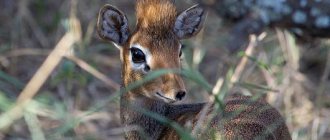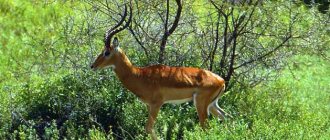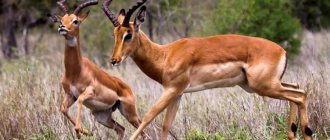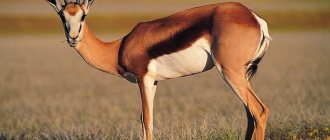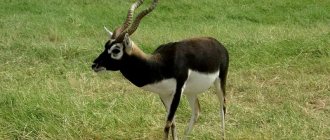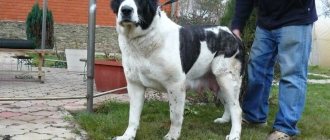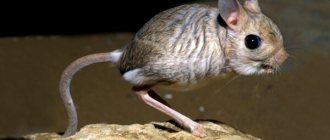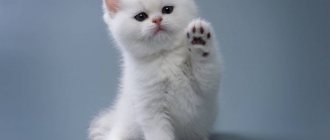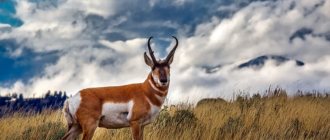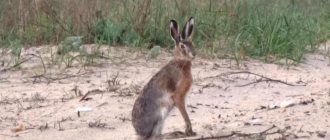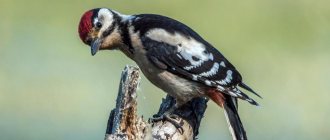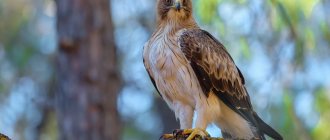The Greater Kudu is a majestic horned antelope. The Greater Kudu is about 1.5 meters tall, its body length reaches 2.5 meters, and its weight is up to 300 kg. The antelope has a brown or gray coat color, vertical thin white stripes run along the sides from the back to the belly, and another characteristic white stripe runs between the eyes. A ridge of hair runs along the ridge, and males also have a white beard. There are other interesting facts about the Greater Kudu.
Greater kudu live along the forests of central, southern and eastern Africa, they try to live along the banks of rivers and lakes. Due to possible attacks from predators, they try to avoid open areas and dense forests. We have collected for you the most interesting facts about great kudu.
Description of the great kudu
The body color of the greater kudu varies from reddish-brown to bluish or blue-gray. Darker individuals were found in the southern populations of the species. The coat color of males darkens with age. The young are similar in color to the females. They are lighter in color and do not have horns. The kudu has six to ten vertical white stripes on its back. The tail is black with a bleached underside. Males, unlike females, have a characteristic white beard.
Appearance, dimensions
Kudu antelopes are quite large animals compared to their relatives. The male can reach up to 1.5 meters at the withers and weigh more than 250 kg. Despite such large sizes, these artiodactyls have a rather light and graceful body structure, due to which they are famous for their great skill in jumping and running. Even the heaviest kudu antelope can jump five-foot farm fences and other obstacles in its path while fleeing.
The horns of a mature kudu bull most often have two and a half curves. If theoretically you straighten them and measure them, the length will easily reach 120 centimeters. However, sometimes there are individuals with three full curls, the length of which in a straightened state can reach 187.64 centimeters.
Antlers do not begin to grow until the buck is 6-12 months old. The first curl curls at the age of two, and until the age of six those same two and a half curls are formed. Kudu antelope horns have long served various traditional African communities as both jewelry and a musical instrument. The latter included the shofar, the Jewish ritual horn blown on Rosh Hashanah. The animal uses them as a defensive weapon or an aesthetic element in the process of attracting a potential mate.
Kudu are quite beautiful antelopes. Their muzzle is elongated, between their coal-black eyes there is a white stripe. The ears are large, set high, oval in shape with pointed tips. There is a white spot under the nose, which in males turns into a beard.
Lifestyle, behavior
Females live in small herds, most often consisting of 1-3 individuals and their offspring. In rare cases, the number of individuals in one herd reaches 25-30 individuals. There is no obvious hierarchical rank in these groups. Sometimes women's groups merge into larger ones, but these are only temporary.
Males live separately from females, in bachelor herds. The number of individuals in such groups ranges from 2-10 animals. It has not yet been clarified whether there is a clear hierarchical rank in the herd. Males of bachelor herds do not overlap each other's ranges, but the range of one male may overlap two or three ranges of female herds.
Males and females do not have lifelong mating relationships and are close only at the time of reproduction, which in South Africa takes place in April and May.
Greater kudu are not very aggressive animals; they show hostility mainly in captivity. In the wild, only males can compete with each other in the process of separating females for mating.
How long does a kudu live?
The kudu antelope in its natural habitat can survive from 7 to 11 years. In artificial, favorable conditions, animals live up to twenty years.
Sexual dimorphism
Greater kudu (lat. Tragelaphus strepsiceros) is a beautiful antelope, the male of which is easily distinguished from the female by its spectacular, spirally twisted horns, reaching a length of about one and a half meters. The male kudu also has six to ten thin white, vertical stripes on its coat. The body color can be yellowish-brown or gray-brown, its fur is an order of magnitude darker.
The female greater kudu is smaller than the male and lacks impressive horns. The cloven-hoofed lady also differs in the color of her coat. Females are always lighter in color and look more like juveniles that have not yet acquired horns. This coat color helps immature kudu and females camouflage themselves more effectively against African vegetation. Shades vary from sandy yellowish-gray to red-brown, against which the thin stripes on the body are more striking.
Both sexes have a ridge of hair that runs along the middle of the back and forms a kind of mane. Also in both sexes there is a distinct white stripe running down the face between the eyes. The large, round ears of the great kudu give the animal a slightly comical appearance.
Return to content
Western eland
This variety is larger than the previous one (height at the withers reaches 175 cm, weight – up to 900 kg). The horns of Western elands are much longer than those of common elands, but are similar in type. In terms of build, representatives of this species are compared to bulls and African buffalos. By the way, both of them are united by the fact that they are all artiodactyls. But most importantly, elands, like all antelopes, belong to the Bovid family. What does it mean?
The antlers of antelopes do not change and do not branch, like, for example, those of deer. They are a horny sheath starting from the frontal bones. Such formations grow throughout life, as a result of which new annular grooves appear on them year after year.
Goats, rams, and cows have this type of decoration. All these domestic animals also belong to the Bovids and are considered relatives of antelopes. Moreover, scientists, in order not to bother, decided as follows. If a representative of this family is not a large or small horned animal, then it is considered an antelope.
Thus, the animals we describe do not constitute a taxon (a single group). This is simply a collection of subfamilies of a wide variety of bovids that are not systematically domesticated. That is why the appearance of an antelope can be the most unexpected. And representatives of different subfamilies may be completely different from each other.
Subspecies of greater kudu
The common name kudu comes from the indigenous Koikoi language used in southern Africa. The scientific name comes from the Greek: Tragos, which means goat and elaphus - deer; Strephis means "twist" and Keras means "horn".
The subspecies of the kudu antelope are represented by two representatives - the greater and lesser kudu. The body weight of a male large kudu reaches 300 kilograms, while that of a small one does not exceed 90 kilograms. Large - distributed throughout the territory from central to southern and eastern Africa. The small one inhabits the territories of eastern Africa. They can also be found in the Arabian Peninsula.
The greater kudu, in turn, forms 5 more subspecies. Among them are T. strepsiceros strepsiceros, T. strepsiceros chora, T. strepsiceros bea, T. strepsiceros burlacei and T. strepsiceros zambesiensis.
Return to content
Lifestyle, behavior
Females live in small herds, most often consisting of 1-3 individuals and their offspring. In rare cases, the number of individuals in one herd reaches 25-30 individuals. There is no obvious hierarchical rank in these groups. Sometimes women's groups merge into larger ones, but these are only temporary.
Males live separately from females, in bachelor herds. The number of individuals in such groups ranges from 2-10 animals. It has not yet been clarified whether there is a clear hierarchical rank in the herd. Males of bachelor herds do not overlap each other's ranges, but the range of one male may overlap two or three ranges of female herds.
Males and females do not have lifelong mating relationships and are close only at the time of reproduction, which in South Africa takes place in April and May.
Greater kudu are not very aggressive animals; they show hostility mainly in captivity. In the wild, only males can compete with each other in the process of separating females for mating.
Range, habitats
The greater kudu's distribution range extends from the mountains of southeastern Chad into Sudan and Ethiopia, and throughout the arid regions of eastern and southern Africa. In South Africa, the antelope is found mainly in the north and east, as well as in isolated population groups in the Cape Province.
The Greater Kudu inhabits the savannah, especially in hilly, broken terrain, as well as forests along watercourses. This species tends to avoid open steppe and forest.
It is most common in southern Africa, but smaller populations of three different subspecies occur in East Africa, the Horn of Africa and Southern Sahara. Their preferred habitat is lightly wooded savannah and areas strewn with rocks and bushes, where they usually hide from predators, which include lion, leopard, hyena and wild dog.
Return to content
Interesting facts about everything in the world
Greater kudu is often attacked by predators: lions, hyenas, wild dogs, and leopards. Sometimes males fight back using their horns, but more often they run away. Greater kudu, when pursued by predators, may suddenly stop to assess the situation, and at this moment, as a rule, they are attacked. People, of course, cause the most damage to antelopes.
Kudu horns are a valuable trophy, for which animals are killed. These were all the interesting facts about the great kudu that we prepared for you.
The article was read by 5,121
Diet of the kudu antelope
Greater kudu are herbivores. Feeding and watering times are most often associated with darkness - evening or pre-dawn. Their diet consists of a wide variety of leaves, grasses, fruits, vines, flowers and some poisonous plants that other animals do not eat. The composition of food varies depending on the time of year and the territory occupied. They can survive the dry season, but will not be able to survive in a potentially waterless region.
The long legs and neck of the kudu allow it to reach food located at high altitudes. In this indicator, only the giraffe is ahead of it.
Return to content
Light-eyed animals
The antelope got its name from the Greek “antolope”, which means light-eyed. Thanks to the special properties of her eyes, she sees almost everything around her. Nowadays, almost all species of antelope, and there are about 80 of them, can be found in the savannas of Africa. They live in different climatic conditions. While some can survive in bushes, forests or savannah, others live in treeless steppes or in arid deserts.
Here is just a short list of antelopes. There are about 100 species in the world.
Reproduction and offspring
During the breeding season, the necks of mature males swell. This is necessary in order to show the bulging muscles. The male, pursuing the performance of a special ceremony, approaches the female sideways, directing his gaze in the direction opposite to the potential lady. If the male’s courtship is not to her taste, the female hits him in the side. If they do, she defiantly runs away, provoking a chase.
During this period, cases of aggression between males are common.
When rival gentlemen meet on the same territory, one takes a position that maximizes the effect of his overall superiority over his opponent. He stands sideways, arching his back as high as possible and pressing his head to the ground. The other one starts walking around. The first participant in the conflict turns, depending on the opponent’s movements, so as to expose his side to him. These ritual adventures sometimes escalate into fierce battles, but not always. It is interesting that at the moment of direct combat they will both turn around, exposing their horns to strike.
The fight takes place through attacks with horns. In a fight, opponents often lock onto each other, sometimes intertwining so closely that they fall into a trap. Unable to escape from the strong castle, most often both males die.
Greater kudu tend to breed seasonally in southern Africa. At the equator, they graze during the rainy season, which lasts from February to June, and mate at or after the end of the rains. If the female has enough plant food, she can produce offspring every two years. However, most females do not reach maturity until three years of age. Males mature after five years.
The gestation period of the great kudu is from 7 to 8.7 months, and the babies are born when the grass is at its highest. The calves remain hidden from prying eyes for another two weeks, after which they, already strong enough, can be brought into the herd. Babies are separated from their mother at the age of six months. Male calves remain in the maternal herd for 1 to 2 years, and female calves longer, up to a lifelong stay.
Reproduction rates in kudu are small; most often only one calf is born in a litter.
Impala
But male impalas have not one, not even three, but several dozen wives who graze in one herd. And during the mating season, the “four-legged sultan” chooses those suitable for mating. The females of the harem are not related. And therefore, in the herd, a certain indifference predominates in relationships.
However, it is customary to help girlfriends “make a mess”, that is, lick each other. Well, and provide other small services. The composition of such a herd is variable. Some members come, some go. And males constantly organize tournaments, challenging the territory and attention of their friends. Of course, both go to the winners.
Impalas are outwardly very perfect antelopes. In addition, representatives of the genus are among the most adapted. They perfectly adapt to the environment and its conditions; not picky about food, unlike some other species. In drought, they are able to do without water, using plant moisture. Black tufts of hair on their hind legs hide scent glands that leave conventional marks in the occupied territory.
Young individuals are famous for their incredible jumps, almost reminiscent of flight. In this way they overcome many obstacles. For example, small rivers, ravines and trees, thickets of bushes. Their jumps are three meters high and ten meters long. Such animals live in open African savannas in the east and south of the continent.
Natural enemies
Greater kudu are prey for several species of animals in Africa, including lions, leopards, wild dogs and spotted hyenas. When an artiodactyl encounters potential danger, it almost always flees. Before this, the kudu makes rotating movements with its tail. Also, at the moment of danger, the horned antelope freezes motionless for a while and moves its ears in different directions, after which it emits a loud roaring signal to warn of the danger of its relatives and runs away. Despite its bulky size, it is a surprisingly agile and skillful jumper. At the same time, the branched horns do not interfere with the males at all. While galloping through thorny thickets, the animal raises its chin so that the horns are pressed as closely as possible to the body. In such an advantageous body position, he manages not to cling to the branches.
Also, as in most cases, the danger to the animal is the person himself. Also, the warlike attitude towards kudu is reinforced by the fact that these artiodactyls are not averse to feasting on the harvest from local agricultural lands. Since ancient times, a shot kudu has been considered a great trophy in the catch of any hunter. The object of extraction was animal meat, skin and the most valuable horns - the object of hunting by collectors. Local residents use them in rituals, for storing honey, as well as for making various devices and instruments, including musical ones. Habitat loss is another threat to the kudu population. Awareness and responsible travel are key to the conservation of this species.
Return to content
Gazelles
Since all antelopes are so diverse in appearance and habits, so as not to get confused among them, we will further tell you about the members of the subfamily of True antelopes. At least we will know who scientists classify as such. And we will get acquainted with representatives of the Gazelle family. Yes, they are indeed considered real antelopes, although many believe that antelopes and gazelles are completely different animals. This is such a confusion.
Of all the antelopes, gazelles are perhaps the most graceful and long-legged. And excellent long-distance runners. Throughout the entire journey, they are capable of maintaining a significant speed of 50 km/h (some varieties up to 70 km/h). These representatives of the fauna live in the savannas of Asia and Africa.
The Gazelle genus includes more than a dozen species. Individuals of each of them differ significantly in parameters. But to keep it simple, let's say that these are medium to small sized antelopes. A remarkable decoration of males are their neat, thin horns, slightly curved at the ends. In females they are either smaller or absent altogether.
Population and species status
The greater kudu is classified as a species of Least Concern on the IUCN Red List. Its popularity is still quite high today in parts of southern and south-central Africa. But encountering this animal in East Africa is considered an increasingly unusual event. The species is considered endangered in Somalia and Uganda and vulnerable in Chad and Kenya.
In addition to extermination by natural enemies and hunters, the great threat to the antelope is human intrusion into its natural habitat and its destruction.
The greater kudu population is also susceptible to outbreaks of diseases such as anthrax and rabies. But fortunately, recovery from the disease accounts for a higher percentage than mortality. The Greater Kudu is widely represented in national parks and reserves such as the Selous Game Reserve in Tanzania, the Kruger National Park and the Baviaanskloof Protected Area in South Africa. The latter area is part of the important World Heritage Site, the Cape Flower Kingdom.
Return to content
Blue wildebeest
The second type of wildebeest is larger. The body length of such animals is almost two meters, height is about 130 cm, weight is about 240 kg. Special glands on their snout help them mark territory. They have a bluish-gray color, marked by transverse dark stripes.
These representatives of the fauna live in African savannas, mostly in the east of the continent. They roam in search of food among plains with low-growing grasses and on hills. Sometimes they find themselves in areas covered with thorny bushes and sparse dry trees. They leave places where food supplies have been depleted and immediately go to look for other, more favorable ones, where the grass is greener and juicier.
In Kenya and Tanzania, the local population is accustomed to considering wildebeest as very stupid animals. The fact is that every year during the dry period, huge herds travel a long way to get to watering places. But flocks of crocodiles are already waiting for them there.
In the terrible toothy mouth of these predators, a tenth of the arriving defenseless herbivores die time after time. But the next year they set off again along the same route, so that the outcome of the journey would again be the same.
Ostrich (Struthio camelus)
Interesting facts about ostriches
Non-flying birds, ostriches are the largest birds in the world. They have a length from 2 to 2.7 m and weigh up to 160 kg. Ostriches are found in the savannas and desert lands of Central and Southern Africa.
Ostriches are also known as "camel birds" because they can withstand high temperatures and live for long periods of time without water.
The soft and smooth feathers of adult male ostriches are black and their tail is white. In contrast, females have gray-brown feathers. The neck of ostriches is long and bare.
With powerful long legs, ostriches can reach a top speed of 69 kilometers per hour. Each ostrich's foot has very sharp claws. Their legs are powerful enough to kill a person with one blow. Ostriches use their legs as their primary weapon for defense against potential predators such as lions, leopards, cheetahs and hyenas.
Ostriches live in small herds of 10-12 individuals. 15 cm in length is the size of the largest eggs in the world that ostriches lay. These huge birds are omnivores and they feed on leaves, roots, seeds, lizards, insects and snakes. Ostriches also swallow pebbles and small stones to grind up food in their stomach.
Predation[edit]
female surrounded by flies
The greater kudu's predators typically consist of lions, spotted hyenas, and African hunting dogs. Although cheetahs and leopards also prey on larger kudu, they usually target the more vulnerable cows and calves rather than adult bulls. Several cases have been reported of Nile crocodiles preying on larger kudu,[9][10] although larger carnivorous mammals are statistically much more dangerous to kudu and comparable large ungulates, or at least to those that prefer dry animals. , elevated areas above coastal waters or marshes. [11] When the herd is threatened by predators, the adult (usually the female) barks to warn the rest of the herd. Although very agile on rocky slopes and in the mountains, the greater kudu is not fast enough (or has sufficient stamina) to outrun major predators in open areas, so it tends to leap over bushes and small trees to push away pursuers. . [2] Greater kudu have excellent hearing and keen eyesight, which helps them warn of approaching predators. [3] Hidden coloration and markings protect Kudu by camouflaging them. If they are alarmed, they usually stand still and are very difficult to detect [12]
Sexual dimorphism
Greater kudu (lat. Tragelaphus strepsiceros) is a beautiful antelope, the male of which is easily distinguished from the female by its spectacular, spirally twisted horns, reaching a length of about one and a half meters. The male kudu also has six to ten thin white, vertical stripes on its coat. The body color can be yellowish-brown or gray-brown, its fur is an order of magnitude darker.
The female greater kudu is smaller than the male and lacks impressive horns. The cloven-hoofed lady also differs in the color of her coat. Females are always lighter in color and look more like juveniles that have not yet acquired horns. This coat color helps immature kudu and females camouflage themselves more effectively against African vegetation. Shades vary from sandy yellowish-gray to red-brown, against which the thin stripes on the body are more striking.
Both sexes have a ridge of hair that runs along the middle of the back and forms a kind of mane. Also in both sexes there is a distinct white stripe running down the face between the eyes. The large, round ears of the great kudu give the animal a slightly comical appearance.
Mandrill (Mandrillus sphinx)
Interesting facts about mandarilla
The mandrill is the largest species of monkey in the world. They have a body length of 60 to 90 cm, and weigh up to 38 kg. Mandrills live in the rainforests and subtropical forests of West and Central Africa.
They are certainly among the most colorful monkeys in the world. They have attractive dense, olive-green fur and a gray belly. The mandrill's cute long nose has a red stripe. Males are larger and more colorful than females.
Mandrills are extremely social animals and they live in large groups of up to 200 individuals.
Besides their coloring and size, these monkeys have long fangs that grow up to 63.5 cm. They use their huge fangs to threaten predators.
Mandrills are active during the daytime. They have cheek pouches to store the food they collect. They are omnivores and feed on fruits, seeds, insects, eggs and worms.
Galago
Interesting facts about galagos
is a small primate that has a length of 15 to 20 cm and a weight of up to 300 grams. They live in the bushes and forests of East Africa.
The galago's thick fur is brown or gray in color. They have very large ears, which give them an excellent sense of hearing. This nocturnal creature also has excellent night vision and large eyes.
Galagos are excellent jumpers as they have very strong back legs. With one jump, the animal can reach a height of 2.25 meters.
Unlike other primates, galagos have an additional tongue that is hidden under the main tongue.
These nocturnal animals spend most of their time in trees. Elastic joints on the legs allow them to move easily between branches. They mainly feed on bark, fruits and insects.
Photo gallery
- Tragelaphus strepsiceros (male).jpg
Male
- Kudu1.jpg
Male
- Young kudu with big ears (Kenya).jpg
Young
- Tragelaphus strepsiceros (female).jpg
Female
- Tragelaphus strepsiceros ♂ (head).jpg
Male head
- Coat of arms of Zimbabwe.svg
On the coat of arms of Zimbabwe
Notes
- Sokolov V. E.
Five-language dictionary of animal names. Mammals. Latin, Russian, English, German, French. / under the general editorship of academician. V. E. Sokolova. - M.: Rus. lang., 1984. - P. 135. - 10,000 copies. - [www.bucknell.edu/msw3/browse.asp?id=14200746 Tragelaphus strepsiceros
] in Wilson DE & Reeder DM (editors). 2005. Mammal Species of the World. A Taxonomic and Geographic Reference (3rd ed.). — Baltimore: Johns Hopkins University Press, 2 vols. (2142 pp.) ISBN 978-0-8018-8221-0 [www.google.com/books?id=JgAMbNSt8ikC&printsec=frontcover&hl=ru]
Shoebill (Balaeniceps rex)
Interesting facts about the shoebill
One of the strangest birds in the world is. The bird has a huge beak that can grow up to 22 cm. This amazing bird can only be found in the swamps of East Africa.
Shoebills are one of the species that may become endangered in the near future. Habitat loss and hunting are their main threats.
Large shoebills can reach 120 cm in length and weigh from 4 to 6 kg. They have bluish-gray plumage and wide wings.
Shoebills are ambush predators, meaning they remain motionless until prey gets close enough to them. Then they make a surprise attack using their powerful beak. The bird's diet consists of lizards, turtles, water snakes and rats.
Shoebill is also one of the loneliest birds in the world. After all, they only get together during the mating season.
Okapi (Okapia johnstoni)
Interesting facts about okapi
is the only remaining relative of the giraffe in the world. They are found only in the tropical forests of the Republic of Congo. The most noticeable feature of okapi is their striped markings, which make them similar in appearance to zebras.
Okapi is one of the most endangered. Habitat loss and hunting are the main threats to this amazing species.
Okapi can reach 2.5 meters in length and weigh between 180 and 310 kg. As a member of the giraffe family, okapi also has a relatively long neck. The coat color is reddish-brown with zebra-like stripes on the hind and forelimbs. This helps okapi easily hide in dense forests. The animal also has a very long tongue, which can reach a length of up to 45 cm.
Okapi often travel 1.2-4 km per day in search of food. Their long tongue helps them easily reach leaves and buds from tall plants.
Eastern colobus (Colobus guereza)
photo Martin Grimm flickr.com
Interesting facts about the eastern colobus
The eastern colobus is one of the most attractive African monkeys. She has bright, glossy, black and white fur and an impressively long tail. It lives in deciduous and evergreen forests of Western and Central Africa.
This is a large species of monkey, their length is 53.8-71 cm and their weight is up to 13.5 kg. Eastern colobus monkeys live in small groups that contain 3-15 monkeys.
These monkeys are active during the day, but spend the most time in the trees. They also take time during the day to search for food sources. Colobus monkeys use different types of sounds and signals to communicate with each other.
This monkey's multi-chambered stomach contains specialized bacteria that help it digest large amounts of food. The diet of the eastern colobus consists mainly of leaves, seeds, fruits and arthropods.
- Eastern crowned crane ( Balearica regulorum )
photo James Ball flickr.com
Interesting facts about the Eastern crowned crane
Standing at 1 meter tall and weighing over 4 kg, the Eastern Crowned Crane is a large bird found in the savannas, rivers and swamps of East and Southern Africa.
The most characteristic feature of this amazing African bird is its crest of golden feathers. The bird's entire plumage is mostly grey, with a pale gray neck and black and white wings. They also have an attractive bright red pouch under their beak.
During the mating season, male cranes perform interesting courtship rituals with females. They dance, jump and make amazing sounds.
The nest of the eastern crowned crane contains from 2 to 5 eggs, and this is the largest average number of eggs among all representatives of the family.
The Eastern crowned crane is an omnivore, feeding on insects, lizards, grasses, seeds, fish and amphibians.
Links[edit]
- ^ a b c d
IUCN Antelope Specialist Group (2008).
"Tragelaphus strepsiceros". IUCN Red List of Threatened Species
.
2008
. Retrieved September 17, 2015. Old form URL - ^ a b c d e f g h
Oddy, Bill (1994).
Wildlife Fact File
. IMP Publishing Ltd. Group 1, map 110. ISBN 0951856634. - ^ B s d e e
Brent Huffman. “Big Kudu. The Ultimate Ungulate Fact Sheet". - "Kudu - Eastern Cape". Noorsveld Safari
. Retrieved May 26, 2022. - "Kudu | African Wildlife Foundation". www.awf.org
. Retrieved May 29, 2022. - ^ a b
Nersting, LG;
Arctander, P. (2001). "Phylogeography and conservation of impala and greater kudu". Molecular Ecology
.
10
(3):711–719. DOI: 10.1046/j.1365-294x.2001.01205.x. PMID 11298982. - Newell, Tony Lynn. "Tragelaphus strepsiceros (greater kudu)". Animal Diversity Network
. Retrieved May 29, 2022. - African Wildlife Foundation (n.d.) Kudu.
Internet. March 4, 2015 https://www.awf.org/wildlife-conservation/kudu - Mills, M. G. L., & Biggs, H. C. (1993). Prey distribution and associated ecological relationships among large carnivores in the Kruger National Park
. In Symposia of the Zoological Society of London (Vol. 65, pp. 253–268). - Cronje, HP; Reilly, B. K.; Macfadyen, I. E. (2002). "Natural mortality of four common ungulate species at Letaba Ranch, Limpopo Province, South Africa". Koedoe
.
45
(1):79–86. DOI: 10.4102/koedoe.v45i1.12. - Owen-Smith, N.; Mills, M. G. (2008). "Predator-prey size relationships in the food web of large African mammals" (PDF). Journal of Animal Ecology
.
77
(1):173–183. DOI: 10.1111/j.1365-2656.2007.01314.x. hdl: 2263/9023. PMID 18177336. - Tilahun, Belete (February 2019). "Ecology and behavior of Kudu (Lesser and Greater Kudu) in Africa". Journal of Biodiversity and Endangered Species
.
73
:2. - ^ a b c
"Kudu". African Wildlife Foundation. - ^ a b c
"Information about the Greater Kudu". Protection of Nature. Archived from the original on 2016-03-09. Retrieved April 29, 2015. - "Great Kudu - Merciful Antelope - Shamwari Private Game Reserve". Shamvari
. 2018-06-19. Retrieved May 26, 2022. - “Toronto Zoo | Animals" . www.torontozoo.com
. Retrieved May 26, 2022. - "Biodiversity Statistics: Latest Estimates (2010-2011)". SANParks: Kruger National Park
. Retrieved July 27, 2015.
